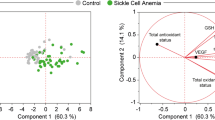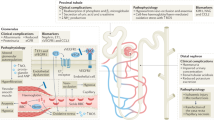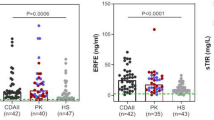Abstract
Sickle cell disease (SCD) is an autosomal, recessive hemoglobinopathy characterized by hemolytic anemia, intermittent occlusion of small vessels leading to acute and chronic tissue ischemia, and organ dysfunction. Red blood cell transfusions are a therapeutic mainstay in SCD and repeated transfusions can result in iron overload. Endocrine dysfunction is the most common and earliest organ toxicity seen in subjects with chronic iron-induced cellular oxidative damage and can be seen in those without clinical evidence of iron overload. The predicted risks of iron overload and endocrine organ failure increase with both the duration of disease requiring transfusion therapy and the number of transfusions. Assessing the state of iron-overload in patients with SCD constitutes a diagnostic challenge because of the unreliability of serum ferritin levels and the risks associated with liver biopsy. In turn, MRI is the preferred noninvasive screening tool for iron overload. This article describes the endocrine and metabolic disorders reported in patients with SCD, discusses their management, and identifies gaps in current knowledge and opportunities for future research.
Key Points
-
Sickle cell disease is an autosomal, recessive hemoglobinopathy that can be complicated by endocrine dysfunction that is most commonly caused by iron overload in these patients
-
MRI, rather than the serum ferritin assay, is the most useful noninvasive screening technique for the detection of the distribution of iron stores
-
Increased disease duration and number of blood transfusions (>8 per year) are predictors of iron overload and have been associated with greater risk of endocrine organ failure
-
The most common types of endocrine and metabolic disorders seen in patients with sickle cell disease include growth failure, osteopenia, hypogonadism, carbohydrate intolerance, and primary hypothyroidism
-
Treatment of endocrine dysfunction includes replacement of particular hormone deficiency and improvement of nutritional status; the goals of hormone replacement therapy for patients with sickle cell disease are to achieve normal levels of circulating hormones, restore normal physiology, and to avoid symptoms of deficiency with minimal side effects
This is a preview of subscription content, access via your institution
Access options
Subscribe to this journal
Receive 12 print issues and online access
$209.00 per year
only $17.42 per issue
Buy this article
- Purchase on Springer Link
- Instant access to full article PDF
Prices may be subject to local taxes which are calculated during checkout
Similar content being viewed by others
References
Ballas SK (2002) Sickle cell anaemia: progress in pathogenesis and treatment. Drugs 62: 1143–1172
Wilson RE et al. (2003) Management of sickle cell disease in primary care. Clin Pediatr (Phila) 42: 753–761
Sickle Cell Disease Guideline Panel (1993) Sickle Cell Disease: Screening, Diagnosis, Management, and Counseling in Newborns and Infants. Clinical Practice Guideline No. 6. AHCPR Pub. No. 93–0562. Rockville, MD: Agency for Health Care Policy and Research, Public Health Service, US Department of Health and Human Services
Genes and Disease NCBI [http://www.ncbi.nlm.nih.gov/books/bv.fcgi?call=bv.View..ShowSection&&rid= gnd.section.98] (accessed 26 October 2007)
Olivieri NF (2001) Progression of iron overload in sickle cell disease. Semin Hematol 38 (Suppl 1): 57–62
Batts KP (2007) Iron overload syndromes and the liver. Modern Pathology 20 (Suppl 1): S31–S39
Walter PB et al. (2006) Oxidative stress and inflammation in iron-overloaded patients with β-thalassaemia or sickle cell disease. Br J Haematol 135: 254–263
Chatterjee R and Katz M (2000) Reversible hypogonadotrophic hypogonadism in sexually infantile male thalassaemic patients with transfusional iron overload. Clin Endocrinol (Oxf) 53: 33–42
Phillips G Jr et al. (1992) Hypothyroidism in adults with sickle cell anemia. Am J Med 92: 567–570
el-Hazmi MA et al. (1991) Endocrine functions in sickle cell anaemia patients. J Trop Pediatr 38: 307–313
Lukanmbi FA et al. (1986) Endocrine function and haemoglobinopathies: biochemical assessment of thyroid function in children with sickle cell disease. Afr J Med Med Sci 15: 25–28
Fung EB et al. (2006) Increased prevalence of iron-overload associated endocrinopathy in thalassaemia versus sickle cell disease. Br J Haematol 135: 574–582
Alustiza JM et al. (2007) Iron overload in the liver diagnostic and quantification. Eur J Radiol 61: 499–506
Harmatz P et al. (2000) Severity of iron overload in patients with sickle cell disease receiving chronic red blood cell transfusion therapy. Blood 96: 76–79
Martin DR and Semelka RC (2005) Magnetic resonance imaging of the liver: review of techniques and approach to common diseases. Semin Ultrasound CT MR 26: 116–131
Brittenham GM and Badman DG (2003) Noninvasive measurement of iron: report of an NIDDK workshop. Blood 101: 15–19
Prasad AS and Cossack ZT (1984) Zinc supplementation and growth in sickle cell disease. Ann Intern Med 100: 367–371
Soliman AT et al. (1999) Growth and pubertal development in transfusion-dependent children and adolescents with thalassaemia major and sickle cell disease: a comparative study. J Trop Pediatr 45: 23–30
Barden EM et al. (2002) Body composition in children with sickle cell disease. Am J Clin Nutr 76: 218–225
Thomas PW et al. (2000). Height and weight reference curves for homozygous sickle cell disease. Arch Dis Child 82: 204–208
Prasad AS (1997) Malnutrition in sickle cell disease patients. Am J Clin Nutr 66: 423–424
Hibbert JM et al. (2006) Erythropoiesis and myocardial energy requirements contribute to the hypermetabolism of childhood sickle cell anemia. J Pediatr Gastroenterol Nutr 43: 680–687
Akohoue SA et al. (2007) Energy expenditure, inflammation, and oxidative stress in steady-state adolescents with sickle cell anemia. Pediatr Res 61: 233–238
Barden EM et al. (2002) Body composition in children with sickle cell disease. Am J Clin Nutr 76: 218–225
Soliman AT et al. (1997) Growth hormone secretion and circulating insulin-like growth factor-I (IGF-I) and IGF binding protein-3 concentrations in children with sickle cell disease. Metabolism 46: 1241–1245
Collett-Solberg PF et al. (2007) Short stature in children with sickle cell anemia correlates with alterations in the IGF-I axis. J Pediatr Endocrinol Metab 20: 211–218
Singhal A et al. (1997) Is there an energy deficiency in homozygous sickle cell disease? Am J Clin Nutr 66: 386–390
Balgir RS (1994) Age at menarche and first conception in sickle cell hemoglobinopathy. Indian Pediatr 31: 827–832
Abbiyesuku FM and Osotimehin BO (1999) Anterior pituitary gland assessment in sickle cell anaemia patients with delayed menarche. Afr J Med Med Sci 28: 65–69
Modebe O and Ezeh UO (1995) Effect of age on testicular function in adult males with sickle cell anemia. Fertil Steril 63: 907–912
Abbasi AA et al. (1976) Gonadal function abnormalities in sickle cell anemia. Studies in adult male patients. Ann Intern Med 85: 601–605
Reed JD et al. (1987) Nutrition and sickle cell disease. Am J Hematol 24: 441–455
Li M et al. (2003) Repeated testicular infarction in a patient with sickle cell disease: a possible mechanism for testicular failure. Urology 62: 551
Nahoum CR et al. (1980) Semen analysis in sickle cell disease. Andrologia 12: 542–545
Osegbe DN and Akinyanju OO (1987) Testicular dysfunction in men with sickle cell disease. Postgrad Med J 63: 95–98
Osegbe DN et al. (1981) Fertility in males with sickle cell disease. Lancet 2: 275–276
Osifo BO et al. (1988) Plasma cortisol in sickle cell disease. Acta Haematol 79: 44–45
Rosenbloom BE et al. (1980) Pituitary–adrenal axis function in sickle cell anemia and its relationship to leukocyte alkaline phosphatase. Am J Hematol 9: 373–379
Saad ST and Saad MJ (1992) Normal cortisol secretion in sickle cell anemia. Trop Geogr Med 44: 86–88
Reid HL et al. (1990) Insulin-dependent diabetes mellitus in homozygous sickle cell anaemia. Trop Geogr Med 42: 172–173
Mohapatra MK (2005) Type 1 diabetes mellitus in homozygous sickle cell anaemia. J Assoc Physicians India 53: 895–896
Alayash AI and al-Quorain A (1989) Prevalence of diabetes mellitus in individuals heterozygous and homozygous for sickle cell anemia. Clin Physiol Biochem 7: 87–92
Reid HL et al. (1992) Glycosylated haemoglobin HbA1c and HbS1c in non-diabetic Nigerians. Trop Geogr Med 44: 126–130
Schnedl WJ et al. (1999) HbA1c determination in patients with hemoglobinopathies. Diabetes Care 22: 368–369
Kosecki SM et al. (2005) Glycemic monitoring in diabetics with sickle cell plus β-thalassemia hemoglobinopathy. Ann Pharmacother 39: 1557–1560
Yahaya IA et al. (2006) Serum fructosamine in the assessment of glycaemic status in patients with sickle cell anaemia. Niger Postgrad Med J 13: 95–98
Panzer S et al. (1982) Glycosylated hemoglobins (GHb): an index of red cell survival. Blood 59: 1348–1350
Oerter KE et al. (1993) Multiple hormone deficiencies in children with hemochromatosis. J Clin Endocrinol Metab 76: 357–361
Parshad O et al. (1989) Abnormal thyroid hormone and thyrotropin levels in homozygous sickle cell disease. Clin Lab Haematol 11: 309–315
Ohene-Frempong K and Steinberg MH (2001) Clinical aspects of sickle cell anemia in adults and children. In Disorders of Hemoglobin: Genetics, Pathophysiology and Clinical Management, 641–670 (Eds Steinberg MH et al.) Cambridge, UK: Cambridge University Press
Barden EM et al. (2000) Total and resting energy expenditure in children with sickle cell disease. J Pediatr 136: 73–79
Buison AM et al. (2004) Low vitamin D status in children with sickle cell disease. J Pediatr 145: 622–627
Woods KF et al. (2001) Body composition in women with sickle cell disease. Ethn Dis 11: 30–35
Finan AC et al. (1988) Nutritional factors and growth in children with sickle cell disease. Am J Dis Child 142: 237–240
Chiu D et al. (1982) Peroxidation, vitamin E, and sickle cell anemia. Ann N Y Acad Sci 393: 323–335
Lal A et al. (2006) Bone mineral density in children with sickle cell anemia. Pediatr Blood Cancer 47: 901–906
Miller RG et al. (2006) High prevalence and correlates of low bone mineral density in young adults with sickle cell disease. Am J Hematol 81: 236–241
Fung EB et al. (2007) Markers of bone turnover are associated with growth and development in young subjects with sickle cell anemia. Pediatr Blood Cancer 135: 574–582
Almeida A and Roberts I (2005) Bone involvement in sickle cell disease. Br J Haematol 129: 482–490
Voskaridou E et al. (2005) Deferiprone as an oral iron chelator in sickle cell disease. Ann Hematol 84: 434–440
Kwiatkowski JL and Cohen AR (2004) Iron chelation therapy in sickle cell disease and other transfusion-dependent anemias. Hematol Oncol Clin North Am 18: 1355–1377, ix
Sklar CA et al. (1987) Adrenal function in thalassemia major following long-term treatment with multiple transfusions and chelation therapy. Evidence for dissociation of cortisol and adrenal androgen secretion. Am J Dis Child 141: 327–330
Bainbridge R et al. (1985) Clinical presentation of homozygous sickle cell disease. J Pediatr 106: 881–885
Platt OS et al. (1994) Mortality in sickle cell disease. Life expectancy and risk factors for early death. N Engl J Med 330: 1639–1644
Buchanan GR et al. (2004) Sickle cell disease. Hematology Am Soc Hematol Educ Program 35–47
Acknowledgements
D Smiley is supported by a research grant from the NIH (K12 RR-017643). S Dagogo-Jack is supported by research grants from the NIH (R01 DK-067269) and the General Clinical Research Center (M01 RR-00211). G Umpierrez is supported by research grants from the American Heart Association (0555306B), the NIH (R03 DK 073190-01) and the General Clinical Research Center (M01 RR-00039). Désirée Lie, University of California, Irvine, CA, is the author of and is solely responsible for the content of the learning objectives, questions and answers of the Medscape-accredited continuing medical education activity associated with this article.
Author information
Authors and Affiliations
Corresponding author
Ethics declarations
Competing interests
The authors declare no competing financial interests.
Rights and permissions
About this article
Cite this article
Smiley, D., Dagogo-Jack, S. & Umpierrez, G. Therapy Insight: metabolic and endocrine disorders in sickle cell disease. Nat Rev Endocrinol 4, 102–109 (2008). https://doi.org/10.1038/ncpendmet0702
Received:
Accepted:
Issue Date:
DOI: https://doi.org/10.1038/ncpendmet0702
This article is cited by
-
Association between BCL11A, HSB1L-MYB, and XmnI γG-158 (C/T) gene polymorphism and hemoglobin F level in Egyptian sickle cell disease patients
Annals of Hematology (2020)
-
Endocrine and metabolic complications in children and adolescents with Sickle Cell Disease: an Italian cohort study
BMC Pediatrics (2019)
-
Hypoxaemia affects male reproduction: a case study of how to differentiate between primary and secondary hypoxic testicular toxicity due to chemical exposure
Archives of Toxicology (2013)



